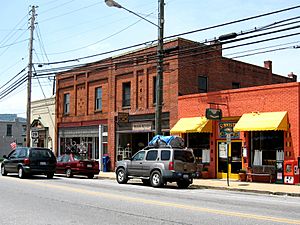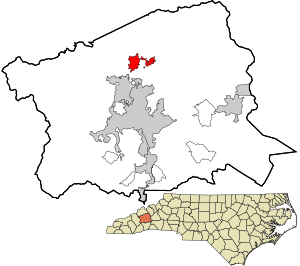Weaverville, North Carolina facts for kids
Quick facts for kids
Weaverville, North Carolina
|
|
|---|---|

Main Street in Weaverville (2009)
|
|

Location in Buncombe County and the state of North Carolina
|
|
| Country | United States |
| State | North Carolina |
| County | Buncombe |
| Area | |
| • Total | 3.89 sq mi (10.07 km2) |
| • Land | 3.88 sq mi (10.05 km2) |
| • Water | 0.01 sq mi (0.02 km2) |
| Elevation | 2,146 ft (654 m) |
| Population
(2020)
|
|
| • Total | 4,567 |
| • Density | 1,177.37/sq mi (454.58/km2) |
| Time zone | UTC-5 (Eastern (EST)) |
| • Summer (DST) | UTC-4 (EDT) |
| ZIP code |
28787
|
| Area code(s) | 828 |
| FIPS code | 37-71560 |
| GNIS feature ID | 2406846 |
Weaverville is a friendly town located in Buncombe County, North Carolina, in the United States. In 2020, about 4,567 people lived there. It's part of the larger Asheville metropolitan area, which means it's close to the city of Asheville.
Contents
History of Weaverville
Weaverville became an official town in 1875. It was named after Michael Montraville Weaver, who generously donated the land for the town. The town is located on a place called Dry Ridge. This name was given by Native Americans because the area was quite dry.
In 1786, the Treaty of Holston was signed. This agreement made it possible for settlers to move into the area. Among the first people to settle here were John and Elizabeth Weaver. They were the parents of the town's founder.
Early residents often gathered for religious meetings, called camp meetings. These meetings took place near the south end of College Street. A large building was constructed in the 1830s. It was used by the Methodist church and became the first school in the area in 1840.
Growth and Education
By 1862, there were 121 families living in the Reems Creek area. Many of them owned large pieces of land. Weaverville College opened in 1873, attracting many families to the town. The house where the college president used to live is now a bed and breakfast.
Weaverville College was a four-year college. In 1912, it became a junior college. Then, in 1934, it joined with Rutherford and Brevard Colleges. Its programs continued at Brevard.
A public school for grades 1-7 opened in 1912 on Church Street. The first full-time public school on Main Street was built in 1921. Older students (grades 11-12) went to school in the Robinsom-Lotspeich house in 1927. This building is now a bed and breakfast called the Inn on Main Street.
Weaverville High School was built by the WPA in 1927. It was located on the south end of Main Street. Later, in 1954, it combined with four other local schools to form North Buncombe High School.
Town Development
Over time, many businesses and homes were built along Main Street. Dr. J.A. Reagan was the first mayor of Weaverville. With a town council, he helped develop roads and walkways. A police chief was also appointed to keep law and order.
The town grew and became more successful when electricity arrived. An electric trolley also helped the town prosper. This led to a boom in land development. Post offices have been in Weaverville since 1860. They were located in different places, including a log cabin and a store. A new post office was finished in 2001 on North Main Street.
The Weaverville Fire Department started in 1912. Their first fire truck was bought in 1922. The fire station moved a few times before settling on Monticello Road.
Zebulon B. Vance, who was North Carolina's governor during the Civil War, was born nearby. Reems Creek, a stream, flows through Weaverville and past the town's Lake Louise Park. A mill at Reem's Creek was even shown in a famous 19th-century book called "Picturesque America."
Several historic buildings in Weaverville are listed on the National Register of Historic Places. These include the Dr. John G. & Nannie H. Barrett Farm, Brigman-Chambers House, Joseph P. Eller House, Weaverville United Methodist Church, and Zebulon H. Baird House.
Local Businesses
Weaverville is located about 9 miles north of downtown Asheville. Many people who live in Weaverville work in Asheville. However, Weaverville also has its own economy, including some manufacturing.
In 1963, A-B Emblem built a factory in Weaverville. This company is one of the world's largest makers of embroidered patches. A-B Emblem has been one of the town's biggest employers for many years. In 2013, they celebrated 50 years of business in Weaverville. The company makes more than 70 million embroidered patches every year!
Geography of Weaverville
Interstate 26 runs along the western side of Weaverville. You can get on or off the interstate at exits 18, 19, and 21. I-26 goes south about 9 miles to downtown Asheville. It also goes north about 51 miles to Johnson City, Tennessee.
U.S. Routes 25 and 70 start from exit 19. They head west about 52 miles to Newport, Tennessee.
The town of Weaverville covers a total area of about 3.4 square miles (8.9 km2). A very small part of this, about 0.008 square miles (0.02 km2), is water. This includes a man-made lake called Lake Louise, which is on the southern edge of town.
Population Information
| Historical population | |||
|---|---|---|---|
| Census | Pop. | %± | |
| 1880 | 147 | — | |
| 1890 | 216 | 46.9% | |
| 1900 | 329 | 52.3% | |
| 1910 | 442 | 34.3% | |
| 1920 | 606 | 37.1% | |
| 1930 | 848 | 39.9% | |
| 1940 | 880 | 3.8% | |
| 1950 | 1,111 | 26.3% | |
| 1960 | 1,041 | −6.3% | |
| 1970 | 1,280 | 23.0% | |
| 1980 | 1,495 | 16.8% | |
| 1990 | 2,107 | 40.9% | |
| 2000 | 2,416 | 14.7% | |
| 2010 | 3,120 | 29.1% | |
| 2020 | 4,567 | 46.4% | |
| U.S. Decennial Census | |||
2020 Census Details
In 2020, the United States census counted 4,567 people living in Weaverville. There were 1,785 households and 1,072 families in the town.
| Group | Number of People | Percentage |
|---|---|---|
| White (not Hispanic) | 4,091 | 89.58% |
| Black or African American (not Hispanic) | 90 | 1.97% |
| Native American | 11 | 0.24% |
| Asian | 38 | 0.83% |
| Pacific Islander | 3 | 0.07% |
| Other/Mixed | 165 | 3.61% |
| Hispanic or Latino | 169 | 3.7% |
Education in Weaverville
Public schools in Weaverville are managed by Buncombe County Schools.
- Younger students in kindergarten and first grade go to Weaverville Primary School.
- Students in second through fourth grade attend Weaverville Elementary School.
- For fifth and sixth grade, students go to North Windy Ridge Intermediate School.
- Seventh and eighth graders attend North Buncombe Middle School.
At these schools, students from Weaverville learn alongside students from other nearby communities in the North Buncombe school district.
For high school, most Weaverville students go to North Buncombe High School. However, they also have other choices. These include Martin L. Nesbitt Jr. Discovery Academy, Buncombe County Middle College High School, or Community High School.
See also
 In Spanish: Weaverville (Carolina del Norte) para niños
In Spanish: Weaverville (Carolina del Norte) para niños

